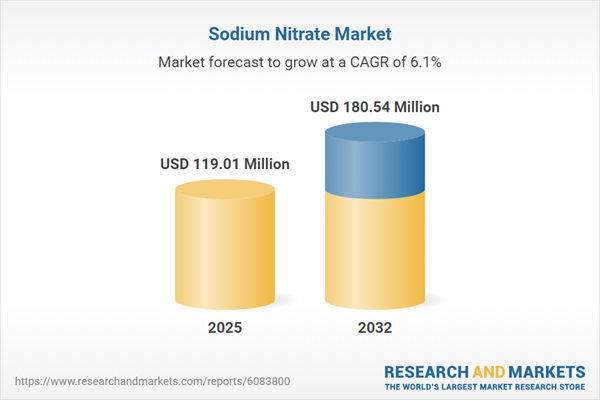Speak directly to the analyst to clarify any post sales queries you may have.
Positioned at the heart of several essential industries, the sodium nitrate market is experiencing notable transformation, propelled by technological advancements, regulatory changes, and evolving supply chain strategies. Demand for sodium nitrate is rising across agricultural, industrial, and emerging sectors, creating new opportunities for decision-makers seeking efficiency and sustainable growth.
Market Snapshot: Sodium Nitrate Market Growth and Outlook
The sodium nitrate market grew from USD 112.26 million in 2024 to USD 119.01 million in 2025. It is expected to continue its upward trajectory at a CAGR of 6.11%, reaching USD 180.54 million by 2032. These gains reflect a robust expansion supported by continued innovation in process technologies, rising demand in high-growth sectors, and strategic responses to global supply and policy shifts.
Sodium Nitrate Market: Scope & Segmentation
This report examines sodium nitrate’s critical applications, supply chain dynamics, and growth potential using deep segmentation and qualitative-quantitative analysis. Key segmentation categories include:
- Application: Chemical intermediate, explosives (construction, military, mining), fertilizer (cereals, fruits & vegetables, oilseeds & pulses), food preservation (cheese manufacturing, meat products), glass manufacturing, heat transfer fluid.
- End Use Industry: Agriculture, chemical manufacturing (industrial chemicals, specialty chemicals), food & beverage, glass & ceramics, mining, pharmaceuticals.
- Grade: Food grade, industrial grade, pharmaceutical grade, technical grade.
- Distribution Channel: Direct sales, national distributor, regional distributor, online channels.
- Region: Americas (United States, Canada, Mexico, Brazil, Argentina, Chile, Colombia, Peru), Europe, Middle East & Africa (United Kingdom, Germany, France, Russia, Italy, Spain, Netherlands, Sweden, Poland, Switzerland, UAE, Saudi Arabia, Qatar, Turkey, Israel, South Africa, Nigeria, Egypt, Kenya), Asia-Pacific (China, India, Japan, Australia, South Korea, Indonesia, Thailand, Malaysia, Singapore, Taiwan).
- Key Players: Sociedad Química y Minera de Chile S.A., Israel Chemicals Ltd., Compañía Minera del Pacífico S.A., Tata Chemicals Ltd., Yara International ASA, Kemira Oyj, Solvay S.A., Shandong Haihua Group Co., Ltd., Seawin Biotech Group Co., Ltd., OCI N.V.
Sodium Nitrate Market: Key Takeaways for Decision-Makers
- Modern industrial and agricultural operations increasingly value sodium nitrate for its versatility, efficiency, and compatibility with sustainability initiatives.
- Technological improvements, such as process intensification and digital monitoring, are reshaping operational efficiency and product consistency.
- Precision agriculture and advanced fertilizer blends are driving new avenues for market penetration, especially in regions with expanding agricultural output.
- Production localization strategies and robust inventory planning are mitigating risks posed by regulatory changes and supply disruptions.
- Specialty application segments—such as advanced heat transfer fluids and specialty glass—are further diversifying demand and encouraging targeted R&D investments.
Tariff Impact: Adapting to Policy Shifts in the Sodium Nitrate Market
United States tariffs introduced in 2025 prompted supply chain realignment, with importers and manufacturers prioritizing domestic sourcing and integration with local mineral processors. This adjustment accelerated investments in captive production facilities and spurred innovation in substitute materials and blending methods, leading to broader sourcing strategies and enhanced long-term resilience for the sodium nitrate value chain.
Research Methodology & Data Sources
This analysis incorporates qualitative interviews with industry experts, manufacturer and distributor surveys, and extensive secondary reviews of trade associations, technical reports, and regulatory sources. Data is validated using triangulation, scenario modeling, supply chain mapping, and examination of best-practice case studies to ensure a balanced, actionable perspective for market stakeholders.
Why This Report Matters: Actionable Insights for Senior Leaders
- Enables strategic planning by clarifying evolving market dynamics across applications, regions, and supply structures.
- Provides executive-level guidance for risk mitigation, operational optimization, and targeted product development.
- Supports sustainable growth through deep analysis of technology, regulation, and shifting customer demand drivers.
Conclusion
Sodium nitrate’s market trajectory is shaped by its pivotal role across essential sectors and the collaborative emphasis on innovation, supply agility, and sustainability. This report equips decision-makers with actionable intelligence to navigate growth, optimize investments, and maintain a competitive edge within a rapidly changing global landscape.
Table of Contents
3. Executive Summary
4. Market Overview
7. Cumulative Impact of Artificial Intelligence 2025
Companies Mentioned
The companies profiled in this Sodium Nitrate market report include:- Sociedad Química y Minera de Chile S.A.
- Israel Chemicals Ltd.
- Compañía Minera del Pacífico S.A.
- Tata Chemicals Ltd.
- Yara International ASA
- Kemira Oyj
- Solvay S.A.
- Shandong Haihua Group Co., Ltd.
- Seawin Biotech Group Co., Ltd.
- OCI N.V.
Table Information
| Report Attribute | Details |
|---|---|
| No. of Pages | 187 |
| Published | October 2025 |
| Forecast Period | 2025 - 2032 |
| Estimated Market Value ( USD | $ 119.01 Million |
| Forecasted Market Value ( USD | $ 180.54 Million |
| Compound Annual Growth Rate | 6.1% |
| Regions Covered | Global |
| No. of Companies Mentioned | 11 |









